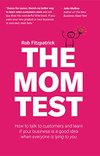The Mom Test: How to talk to customers & learn if your business is a good idea when everyone is lying to you
amazon.com
Saved by Rinkesh Gorasia and
The Mom Test: How to talk to customers & learn if your business is a good idea when everyone is lying to you

Saved by Rinkesh Gorasia and
Rule of thumb: Good customer segments are a who-where pair. If you don’t know where to go to find your customers, keep slicing your segment into smaller pieces until you do.
If you don’t know what you’re trying to learn, you shouldn’t bother having the conversation.
Before we can serve everyone, we have to serve someone. Forgetting about all the possibilities and focusing on who would most likely buy,
If you’ve run more than 10 conversations and are still getting results that are all over the map, then it’s possible that your customer segment is too vague,
Or, in shorter form: Vision / Framing / Weakness / Pedestal / Ask
You’re an entrepreneur trying to solve horrible problem X, usher in wonderful vision Y, or fix stagnant industry Z. Don’t mention your idea. Frame expectations by mentioning what stage you’re at and, if it’s true, that you don’t have anything to sell. Show weakness and give them a chance to help by mentioning the specific problem that you’re
... See moreRule of thumb: It’s not a real lead until you’ve given them a concrete chance to reject you.
Have the problem Know they have the problem Have the budget to solve the problem Have already cobbled together their own makeshift solution
try to convert fuzzy promises into something more concrete.